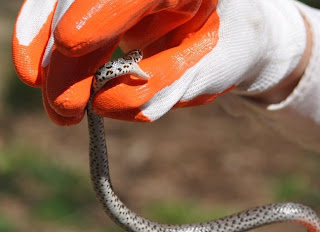
Black Rat Snake. Description: Adult rat snakes are typically 3-5 ft (91-152 cm), but large individuals may be more than 6 ft (183 cm) long. The appearance of rat snakes varies greatly throughout the geographic range. Black rat snakes are more northern in distribution and are characteristically black on top with a faint hint of white between some of the scales. Yellow rat snakes are greenish, yellow, or orange with four dark stripes running the length of the body. Gray rat snakes are dark to light gray with darker gray or brown blotches. The juveniles of all subspecies resemble the gray rat. The belly is whitish in color near the head and becomes checkered or mottled toward the tail. The body cross section is loaf-shaped and not round . Rat snakes have weakly keeled scales and the anal plate is divided.
Range and Habitat: Rat snakes are found throughout every southeastern state and most of the eastern and midwestern states as far north as southern New England and southern Michigan. In our region, black rat snakes are found in the mountains and Piedmont regions of central Georgia and South Carolina. Yellow rat snakes are found along the coast and gray rat snakes are found in southern Georgia and along the Savannah River in Southern South Carolina . Rat snakes occupy a wide variety of habitats including rocky timbered hills, hardwood forests, river floodplains and swamp margins. They are commonly found in abandoned buildings and barns and are often the most common large snake in suburban areas.
Habits: Adult rat snakes primarily eat mice, rats, squirrels, and birds, as well as bird eggs. They are a common predator on wood duck eggs. Juveniles eat small frogs, lizards, and small rodents. Rat snakes are constrictors, and adept climbers that can scale brick walls as well as tree trunks. When frightened they often assume a “kinked” posture and remain motionless. They will vibrate the tail and expel malodorous musk.
Conservation Status: Rat snakes are very common in the Southeast and are not protected.




